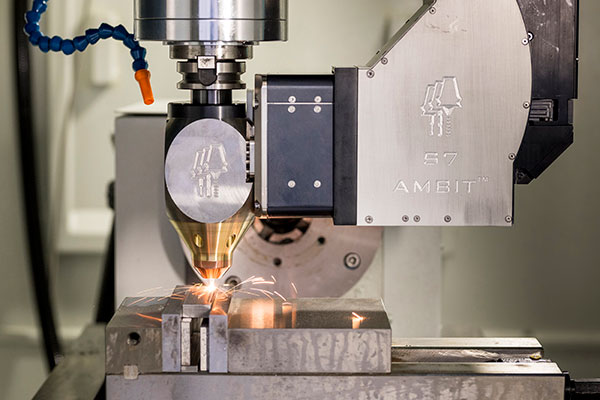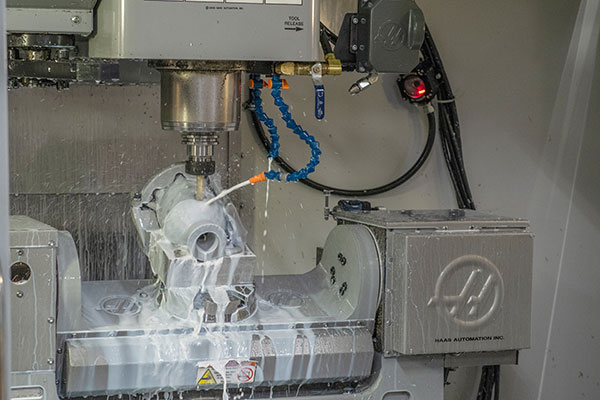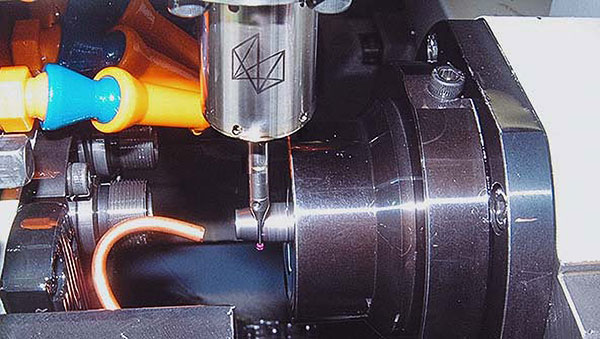Galvanizing Hybrid Manufacturing Workflows
As all-in-one solutions emerge, software and automation are streamlining additive manufacturing and other manufacturing processes into optimized and integrated production workflows.

The AMBIT multi-task system combines AM and machining capabilities in a single system using patented tool-changeable laser cladding heads. Image courtesy of Hybrid Manufacturing Technologies.
Latest News
June 20, 2023
Hybrid manufacturing, the concept of combining multiple production capabilities in a single operation, is gaining traction. Yet instead of one multipurpose piece of equipment, the more likely path to a hybrid scenario will come via software and automation solutions that streamline typically disparate and disconnected processes into an integrated and optimized manufacturing workflow.
Interest in hybrid manufacturing is building for numerous reasons. On one hand, additive manufacturing (AM) is increasingly tapped for production-grade use cases thanks to new materials and improvements to performance and part quality that are driving more favorable cost models. At the same time, software and automation advances, coupled with new hardware innovations, are paving the way for systems capable of combining additive and subtractive capabilities as well as other critical manufacturing processes.
Although merging multiple processes into a single machine has value, it’s not always the optimal way to think about solving the problem, according to Glenn Daehn, the director of HAMMER (Hybrid Autonomous Manufacturing, Moving from Evolution to Revolution) Engineering Research Center. HAMMER, funded by the National Science Foundation, is a partnership between The Ohio State University (OSU), Case Western Reserve University and other industry and education entities to develop new intelligent autonomous manufacturing systems that combine multiple processes to control material properties and component dimensions, resulting in highly customized and high-performance parts.
“Whenever you’re making anything important, whether a car, ship or cell phone, all kinds of processes are involved so you have to think thoughtfully about how to hybridize all of that and take the focus off a singular tool or process,” says Daehn, also the Mars G. Fontana Professor of Metallurgical Engineering at OSU. “What’s really important is to have the workflow go all the way from design to the tools and processes used as well as the controls.”
HAMMER’s vision borrows concepts from design; tools and process convergence; materials state awareness; and control, intelligence and autonomy to develop hybrid autonomous manufacturing systems that can concurrently design materials, initiate topology and automate flexible manufacturing processes based on a large-scale design problem. Consider production of a flap bracket for an airplane—AM technologies could be used to deposit highly wear-resistant materials in critical junctures while also forging and machining other areas to get the desired metallurgical structure. Yet, instead of discrete tasks and handoffs between humans, the design decisions, materials optimization and manufacturing tactics would be intelligent and automated. “When you start to hybridize, all kinds of interesting things happen,” Daehn explains. “It allows you to do something better than any single process … but do so under one workflow.”
New Offerings on the Horizon
As next-generation solutions percolate in research labs, a handful of companies are leveraging more current technologies to deliver an early take on hybrid manufacturing. For example, DMG Mori offers systems that combine directed energy deposition (DED) AM capabilities with computer numeric controlled (CNC) milling and machining functions, integrating the production chain for medical or aerospace applications in a single machine. Matsuura Machinery Corp.’s LUMEX series combines powder distribution, metal laser processing and high-speed, precision milling in a single process while Sodick has another take on integrating metal AM with integral linear motor drive milling in a single system tuned for producing injection molded tooling and other parts. 3D Systems offers the EXT Titan Pellet printer platform, which combines a pellet extruder with three-axis milling in a single machine on the same gantry. Parts can be machined during and after the printing process, which the company says can shorten cycle times.
Hybrid Manufacturing Technologies, which now counts Nikon as an investor, has developed a way to integrate AM capabilities onto existing machine platforms, which allows for multiple manufacturing technologies to be combined in a single setup. The company’s AMBIT tool-changeable laser cladding heads and central control system creates a multitask system capable of doing AM, CNC and inspection work with full digital integration and without requiring people to manually move parts around or convert data between processes, according to Jason Jones, co-founder and CEO of Hybrid Manufacturing Technologies.
There’s a need for streamlined processes and integrated systems because “making things is not that easy,” Jones says. “Most manufacturing processes are not a single-step solution or single set of physics,” he explains. “To get to a finished product, you have to streamline how you go from a digital design to an output where you can realize value. Anything not contributing to that absorbs energy and begets waste.”
The modularity and interchangeability of the AMBIT heads bring some simplicity to the hybrid manufacturing problem, but combining AM and subtractive processes in a single solution isn’t enough. Jones says inspection tools are an important addition because operators need a way to automatically 3D print and test parts to determine whether they have been built properly. “Providing the whole suite is the biggest reason we haven’t seen this before—it’s taken a while to mature,” Jones says.
One potential use case for Hybrid Manufacturing Technologies’ platform is producing a mold system for glass bottles. The AMBIT hybrid system was able to deposit a nickel-based alloy in targeted areas to create hard edges and faces using a directed energy deposition (DED) AM solution inside a CNC machine. The hybrid system’s automation capabilities ensured the system could perform necessary milling work as a holistic process as opposed to navigating it as separate steps. It also allowed multiple materials to be leveraged, ensuring different performance values where needed.
“By enabling DED together with machining, all steps can now be achieved in the same setup along with milling the rest of the mold,” Jones says. The hybrid process also reduces the need for highly skilled or supervised employees to orchestrate handoffs between systems and processes, allowing manufacturers to run the line faster while bringing down the cost of each bottle, he adds.
Process Automation Tackles Key Challenges
Protolabs, a provider of digital manufacturing services, rarely sees a need among its customers to leverage multiple manufacturing methods to produce a single part. However, in a few cases, when necessary, the challenge is more about streamlining workflow between AM and subtractive processes as opposed to depending on any single machine to get the job done, according to Eric Utley, applications engineer on the Protolabs 3D printing team.

Even producing a single part with multiple processes when not in the same system has its fair share of challenges, Utley says. For one, hybrid techniques require a high level of competency in two manufacturing methods, which is not always feasible for companies to maintain.
“Any individual person is usually focused on one manufacturing method and is an expert in designing a part to be made in that process,” Utley explains. “If you’re trying to find an efficient way to make a hybrid part—say, molding something over a 3D printed output—you’ll need someone that understands mold tolerances, how to fixture a part on a mold, and who knows what the best printer and materials are to get the job done. It’s a narrow skill set that you don’t see too much. But the name of the game is trying to capture the core strengths of both manufacturing processes in a single part.”
Given the importance of post-processing in AM operations, Utley expects to see more hardware and automation solutions that make those workflows and handoffs easier as production-grade applications take root. He cited the example of a 3D printed rocket engine project contracted by LPRD Rocketry, a student team at the University of Minnesota (UM), which required a complex cooling channel design to support regenerative cooling.
Protolabs worked with the UM team, including modifying the cooling channel design from circular to teardrop shape for easier printing as well as other changes to eliminate the need for supports. The final design was printed with direct metal laser sintering, but required close use of a CNC milling system to post-process the engine for production use, Utley says.
“In one part, we were able to achieve the complexity of internal geometries using 3D printing and machine better features and tolerances with CNC milling,” Utley says. This is a common practice in segments like aerospace and rocket design, which are increasingly taking advantage of metal AM. As a result, Utley says they could benefit from process automation solutions that would minimize the number of manual handoffs that are typically inefficient and a drain on shop floor resources, he explains.
Hexagon also sees value in supporting hybrid manufacturing processes through software and automation tools that synthesize a cohesive workflow. The company offers solutions that help develop toolpaths for deposition and subtractive systems in addition to its line of m&h production probes (from Hexagon) that add inspection and measuring capabilities to standard CNC machines for a more streamlined, hybrid workflow, notes Mathieu Perennou, global strategy & business development director, Additive Manufacturing at Hexagon’s Manufacturing Intelligence Division.

Hexagon also supports hybrid manufacturing through simulation, allowing engineers to simulate every step of the manufacturing process to consider what happens next. Say, for example, there was a desire to first forge a part and then add a feature to it using a DED approach.
“The Hexagon solutions will allow you to first simulate the forging process (and calculate actual shape, potential distortions, residual stresses, etc.), and then simulate the DED deposition process taking the existing manufacturing history into consideration,” Perennou explains. “We use Simufact solutions to model and simulate the different manufacturing processes and chain them. That way, we can assess the correct final distortions and residual stresses, among other considerations.”
Dyndrite views its offering, which taps multithreaded CPUs and graphics process unit materials and process development tools to streamline industrial metal 3D printing, as a new layer that can enable design-to-production workflows and potentially multimachine production. The software helps reduce the need for supports, minimizing post-processing CNC requirements, yet it can also be used to facilitate complex features such as “soft jaws” that hold a part when it requires a secondary machine for post-processing.
The Dyndrite platform helps machine builders and AM practitioners tackle a number of hurdles that have slowed adoption of AM for mass production, including the ability to develop new materials, speed build rates, print more intricate geometry more easily, improve part quality and reduce support requirements.
“Engineers spend more time and tedium doing things that should be completely automated whether in one machine or multiple machines,” contends Harshil Goel, Dyndrite founder and CEO. “The Dyndrite layer enables processes across machines, and everything is automated through various mechanisms provided, including APIs [application programming interfaces] and Python scriptability. Our intent is to have the foundational layer bring a multimachine manufacturing mentality to both machine vendors and end users.”
In the end, however, engineers should consider hybrid manufacturing strategies as just another tool in the toolkit—not a panacea. “It would likely be for parts that have a combination of opposing requirements—for example, when you need both high complexity and tight tolerances,” says Protolabs’ Utley. “If you can’t hit all the part requirements with a single process, that’s what would trigger a hybrid manufacturing approach. You wouldn’t go that route for the sake of it because by its very nature, it drastically increases complexity.”
More 3D Systems Coverage
More Dyndrite Coverage
Subscribe to our FREE magazine, FREE email newsletters or both!
Latest News
About the Author
Beth Stackpole is a contributing editor to Digital Engineering. Send e-mail about this article to DE-Editors@digitaleng.news.
Follow DE





